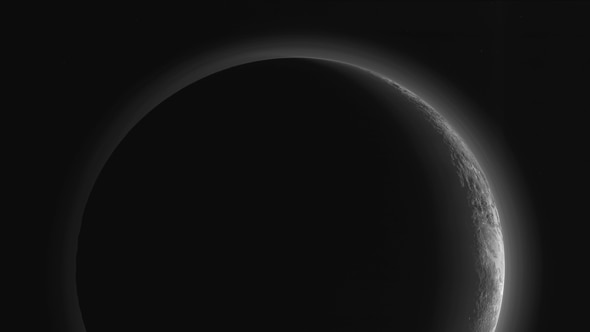Create a free profile to get unlimited access to exclusive videos, sweepstakes, and more!
Crescent Pluto

NASA and the folks on the New Horizons spacecraft team just released a photo of Pluto, and I can say without fear of exaggeration that it is the most stunning shot of the tiny world yet.
Ready?
Are. You. KIDDING. ME?
This shot was taken when New Horizons was just 18,000 km (11,000 miles) from Pluto, just 15 minutes after closest approach. A piece of this image was released back in September, showing a part of the crescent, but after better processing this represents the whole view by the Multispectral Visual Imaging Camera in the instrument playfully called Ralph.
Once I picked my jaw up off my desk, I was able to start poking through the image. First off, make sure you grab the ridiculously huge 8,888 x 5,000 pixel version of this, because holy yikes.
The Sun was off to the right and far, far behind Pluto in this shot, more than 5 billion kilometers away.
Starting at the lower right of the crescent you can see the relatively smooth Sputnik Planum region, part of the “heart” of Pluto. Going around the crescent to the upper left (west) are higher features, mountains up to 3,500 meters high. They would fit right in with the Colorado Rockies … except these mountains aren’t rock, they’re frozen water ice.
On Earth, an ice mountain this big would collapse under its own weight. But Pluto has lower gravity, and at -230°C water ice is as tough as rock on Earth.
In the big version, you can see the long shadows cast on the frozen landscape by these and other higher features. It's magnificent.
You can also see Pluto’s extremely thin atmosphere of nitrogen, methane, and carbon monoxide. The striping is real! It’s due to layers of haze, molecules created when ultraviolet light from the Sun reassembles simpler molecules in the air and on the surface.
There are vast amounts of science in this photo, so much to see and learn about this distant place. And you know how excited I am about that.
But just look at it. That’s Pluto.
Our Universe is beyond beautiful. It is an exquisite work of art, one that we can see through science, understand through science, and appreciate through science.
In so many ways, the two are, quite simply, the same thing.


























